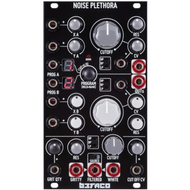Noise Plethora - Befaco
by Sam Chittenden
Befaco's Noise Plethora is a brick of a module dedicated to all [and I mean all] flavors of noise generation. The module packs three channels of digital generators, all with a corresponding multi-mode analog filter and CV control over the majority of the parameters, into a densely packed 14HP. The build quality is rock solid, with some of the sturdiest pots in Eurorack, nice smooth patching jacks and Befaco's trademark red, black, and gray aesthetic.
Noise Plethora has two main channels, A and B, which are identical and consist of knob and CV inputs for X and Y algorithm parameters [what they control is variable depending on which bank or program you are running], cutoff and resonance knobs—along with a attenuator for CV input over cutoff frequency—a three-way switch for selecting the filter mode [low-pass, band-pass, or high-pass] and an output jack. Both channels share a program/bank selection encoder that feeds two separate LCD screens. Each channel also has individual CV inputs for voltage control over program selection. There is a C channel, which is a bit different from A and B, and consists of the same [albeit with smaller knobs] filter setup but with a white noise generator that shares the channel with a granular noise generator which Befaco calls "Gritty" noise. There is a CV input for control over the Grit quality as well as raw outputs for both the Gritty noise and the white noise generators. A filtered output also features a two-way switch allowing a choice between which of the two channel C flavors will be run through the filter. The only parameters without CV inputs are the filter resonance, filter mode selection [or filter source for channel C] and bank selection.
Channels A and B have 3 banks of 10 different noise algorithms to choose from and the banks and programs are all titled and the manual has nice descriptions of each different algorithm's generation model. Each X and Y parameter is described well and offers insight into what is going on, as well as a nice starting point for exploration.
Bank A is titled "Textures" and most are of the banks are variations on cross modulating sine and square waves. Depending on the X and Y settings Bank A programs range from different colors of noisy whitewash all the way to gritty hard-edged madness. I found some great crunchy bass drum tones and some fun clap sounds as well. A few of Bank A's algos lend themselves well to tonal applications [more on that in a bit]. Bank B is called "HH Clusters" and features algorithms with some very math-y descriptions. Most of the programs consist of larger stacks of waves detuned against each other and work well for metallic percussive sounds, which offer a nice variety of inharmonic overtones. The filter really helps to dial in the right amount of bite here, and again, the actual particulars of how the noise is generated is described nicely in the manual. Bank C bears the title "Harsh and Wild" and of the three channels this description is the most telling. The noise in this bank definitely leans into its digital nature and most algorithms are unruly at best. Here you'll find "ExistenceisPain" and "SatanWorkout" among others and for digital drum noise or harsh evolving dronescapes you need look no further. A few of the algorithms even have a built-in reverb for the Y parameter and it sounds great. A droning "BasuraTotal" through the on-board filter in band-pass mode with the reverb cranked up evokes a steam-filled train station at peak rush hour with all the trains simultaneously coming to a screeching to a halt.
There are percussive sounds galore to be discovered here, along with all manner of droning noisescapes. Pairing the Noise Plethora with a module like Befaco's Percall and you've practically got your Eurorack drums covered. The three filter modes add greatly to the options and I had a lot of fun exploring the nooks and crannies of the different algorithms and the way the filter and the X and Y parameters interact to create different flavors and textures. Many of the algorithms, especially when the parameters are in the extremes of their ranges, will produce really interesting glitches and textures, everything from subtle vinyl-like pops and scratches to throbbing, cross-modulating burbling.
Besides an endless source of percussive sounds and a wide variety of ways the Noise Plethora can be used as a modulation source, it works well as a pretty interesting oscillator, too. The filter CV inputs will track 1V/oct and with the resonance cranked you can coax some fun and dirty tonal sequences out of the Noise Plethora. Results will vary and be heavily dependent on the algorithms you choose along with the various settings, but the Noise Plethora can be awesome for a crispy, gritty, and textural voice with minimal effort. Sequencing the resonance and modulating the X and Y parameters can lead to complex, rich, and [ahem] noisy voices. Old cassette tape vibes are easy to come by, sandy voiced leads, or airy, whispery tones can all be found with just a few sweeps of the Noise Plethora's controls. And that's just one channel. With so many different algorithms to explore and the somewhat unpredictable and chaotic nature of the interactions it's hard to predict exactly what you'll coax out of the this module. I was surprised at how many musically useful results I could find, and am more than satisfied by the vast variety of percussive possibilities. One thing is for certain; it's the last noise generator you'll ever need.
14 HP +12v 110mA -12v 67mA
Price: $349


